Opportunistic Real Estate Investing
A Guide to a Sophisticated Strategy
STRATEGIES
Brookfield Oaktree | $203B AUM
2/2/2025
What Is Opportunistic Real Estate?
Opportunistic real estate investing targets real estate situations that come with unique challenges or complexities that, when expertly managed, have the potential to generate outsized returns. Investments often include properties, but may also include real estate companies, distressed real estate loan and real estate debt securities. The strategy aims to acquire these assets at discounted valuations and generate strong returns through value-enhancing improvements in capital structures, property development and operational efficiencies.
Opportunistic real estate investments’ unique characteristics can make them difficult to source—and once acquired, they require extensive
work and real estate experience to realize a profit. As such, it’s important for managers to have the local market knowledge, experience, scale and operating capabilities required to source deals and efficiently drive improvements forward to deliver attractive returns.


With heightened volatility in real estate capital markets leading to distress for some real estate owners, the current environment could be the best time in years for opportunistic real estate investment.
What Do Opportunistic Real Estate Strategies Look Like?
Opportunistic real estate investing utilizes several strategies to drive attractive returns, including significant redeveloping or repurposing of an existing building, new ground-up developments, business building in fragmented sectors through enhancing operations, large-scale portfolio transactions, single-asset acquisitions to build portfolios, or distressed assets in need of a new capital structure. Each of these strategies requires sophisticated manager skill.
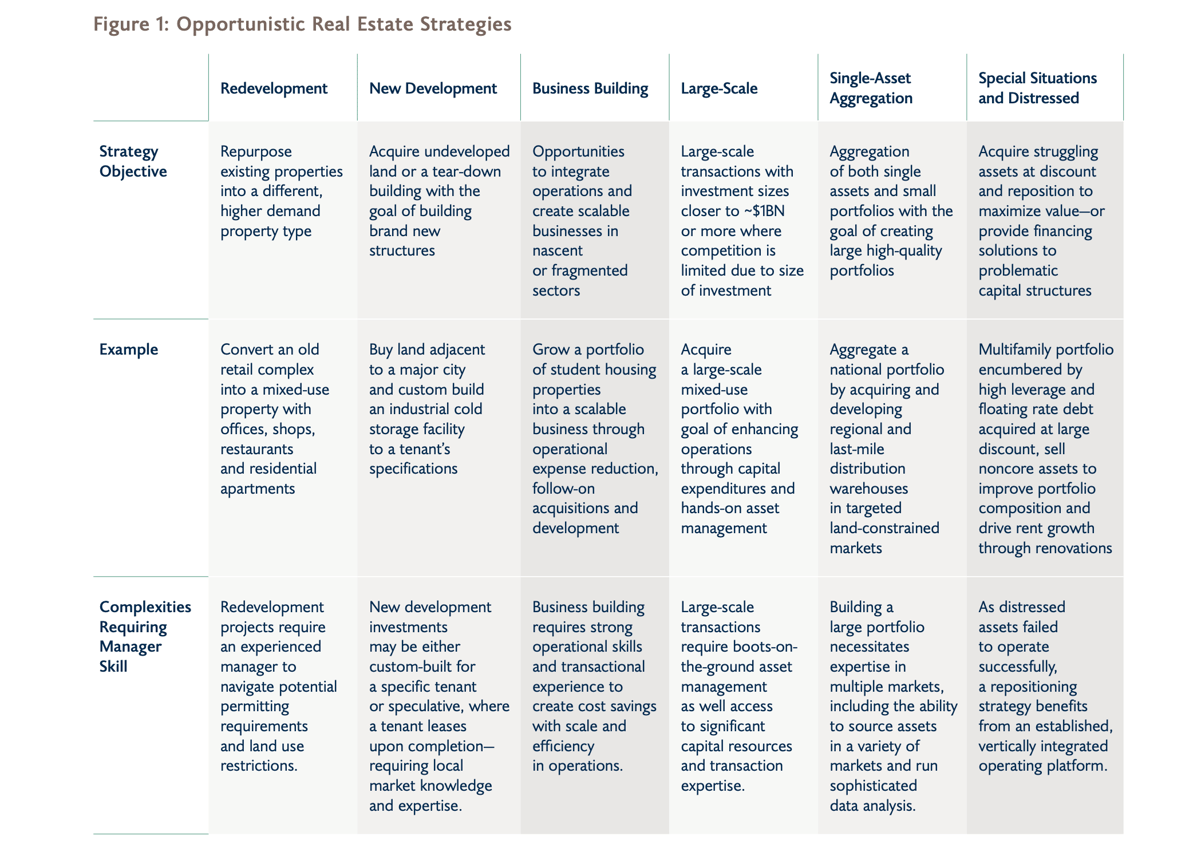



Why Opportunistic Real Estate Now?
While opportunistic real estate can be an effective strategy throughout all phases of the market cycle, opportunities to acquire stressed real estate tend to be most abundant during periods of market volatility and macroeconomic instability.
Current market conditions make a compelling case for opportunistic real estate investment. The capital markets volatility that ensued after the 2022-2023 rapid rise in interest rates placed stress on borrowers and depressed traditional bank lending. From 2023-2024, the higher cost of capital drove transaction volumes 64% lower over these two years than the same period over 2021-2022, putting downward pressure on valuations (Figure 2).
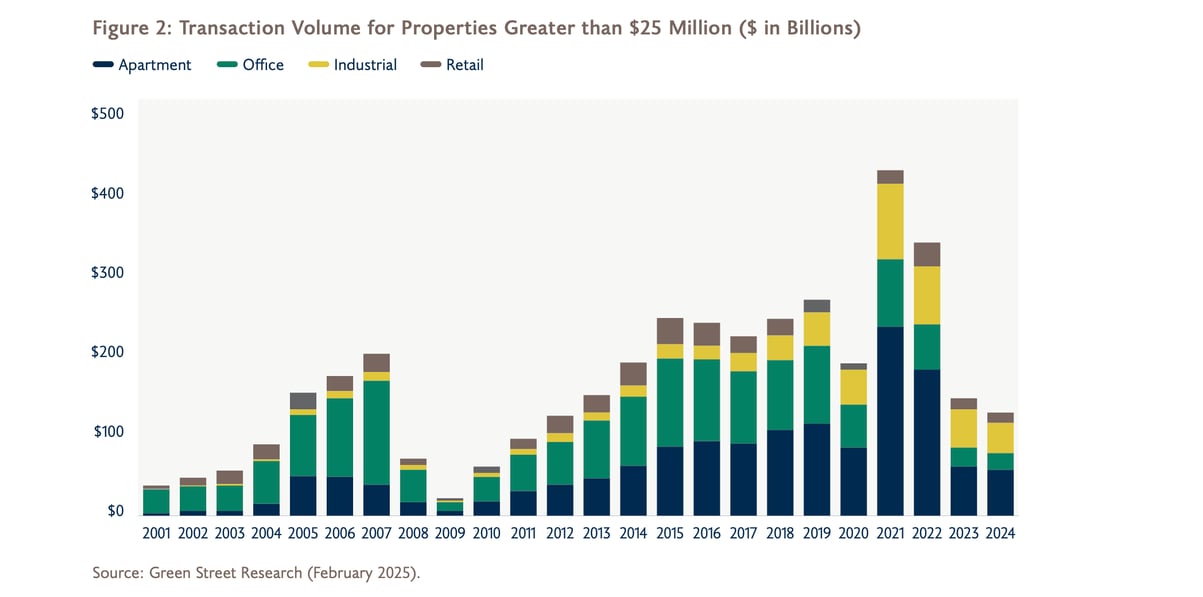

In 2024, interest rates moved lower in response to decreased inflation. The stabilization in interest rates led to a reopening of capital markets, in part due to lower borrowing costs creating a more favorable backdrop for real estate investing. Commercial real estate values increased 5% in 2024, according to the Green Street Commercial Property Price Index. Transaction volume also picked up modestly in the latter half of 2024, supported by lower interest rates and an active debt capital market that saw CMBS issuance increase nearly threefold year over year.
At the same time, a large quantity of debt issued when interest rates were low is due to mature over the next few years (Figure 3). These headwinds for borrowers create compelling conditions for opportunistic real estate investors, as undercapitalized borrowers become motivated sellers, seeking to offload assets they can no longer manage or finance. In addition, limited liquidity may lead to less competition for investments, and more favorable pricing.
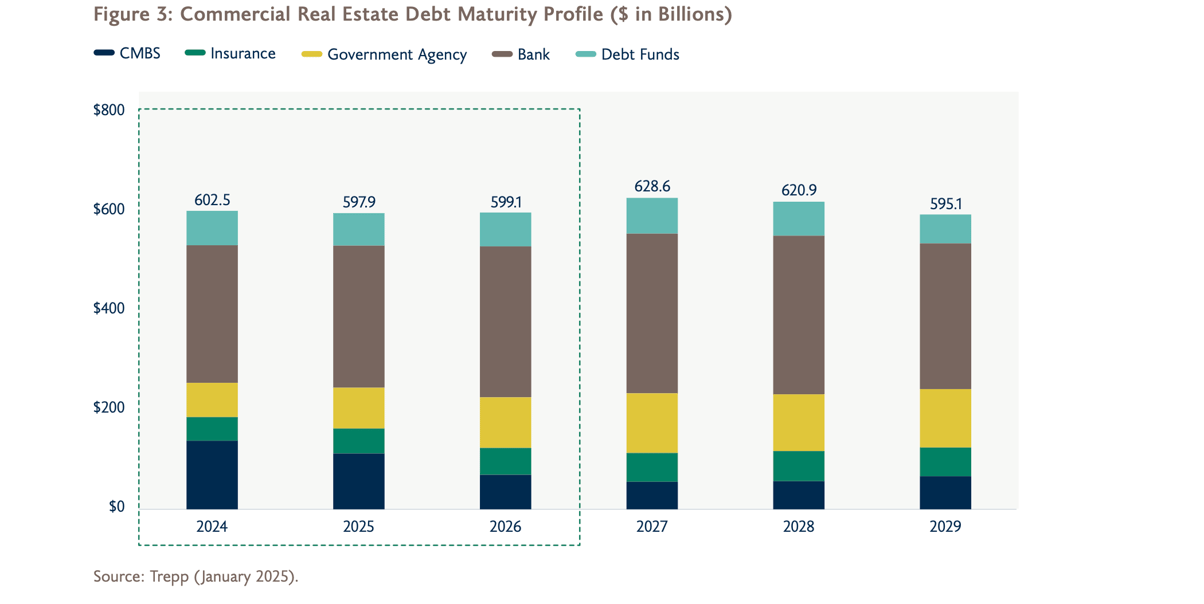

Meanwhile, underlying real estate fundamentals are strong, bolstered by high demand and limited supply across several sectors. Inflation has settled somewhat closer to historical averages, which when combined with active asset management, should support strong revenue growth in real estate investments over the long term. In addition, supply
is muted as rising replacement costs curtail new development.
Major shifts in demographics, geopolitics and consumer preferences are also spurring real estate demand. Declining household affordability combined with higher mortgage rates, delays in household formations, and a desire for professionally managed communities with amenities have led to an increased demand for rental housing. Consumers are also exhibiting new working and consumption habits that emphasize experiences, leisure and flexibility, which is impacting the way real estate is used in hospitality, entertainment, logistics and self-storage sectors. In addition, recent disruptions to global supply chains and ongoing geopolitical pressures are driving companies and governments to strategically onshore supply chains, in turn producing potential opportunities in the science and innovation and logistics sectors. We believe these dynamics represent tailwinds for opportunistic investing in high-quality real estate in the coming years.
How Does Opportunistic Real Estate Fit in a Portfolio?
Opportunistic real estate investing is one of four primary real estate strategies—the others being core, core-plus, and value-add real estate investing (Figure 4).
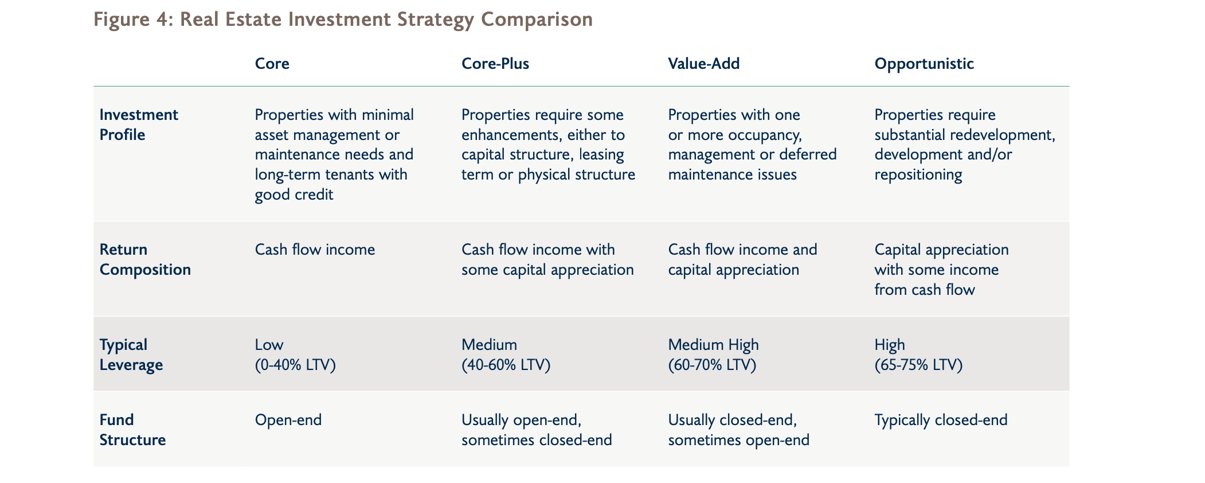

When compared to these other strategies, opportunistic real estate has more levers available to drive returns (Figure 5).
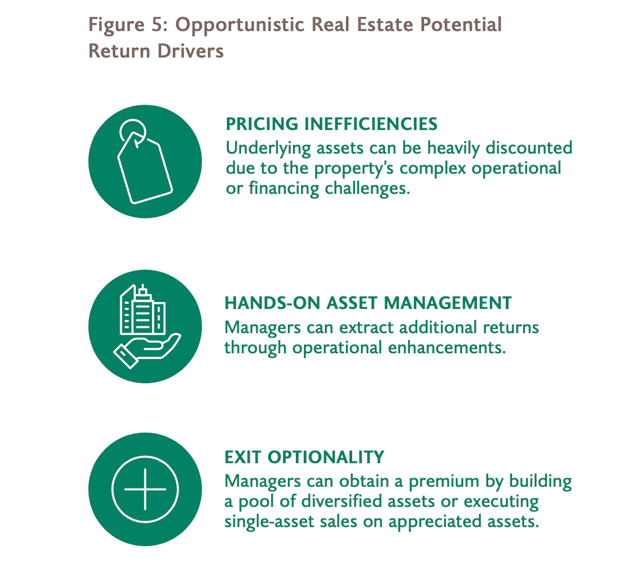



In addition to greater return potential, opportunistic real estate managers generally have more flexibility over the property’s operational plan. This allows for ease of repositioning the property for a specific use based on location, corresponding demand and potential returns. The success of these methods
can lead to significantly higher returns than other real estate strategies.
An allocation to opportunistic real estate may offer the potential for an outsized return, which it generates through capital appreciation rather than steady income. As opportunistic real estate situations can arise throughout the market cycle, investors often seek long-term static allocations to maximize the potential
to capture higher returns. However, it is essential that investors understand the strategy’s risk-return profile to determine if it aligns with their portfolio objectives.
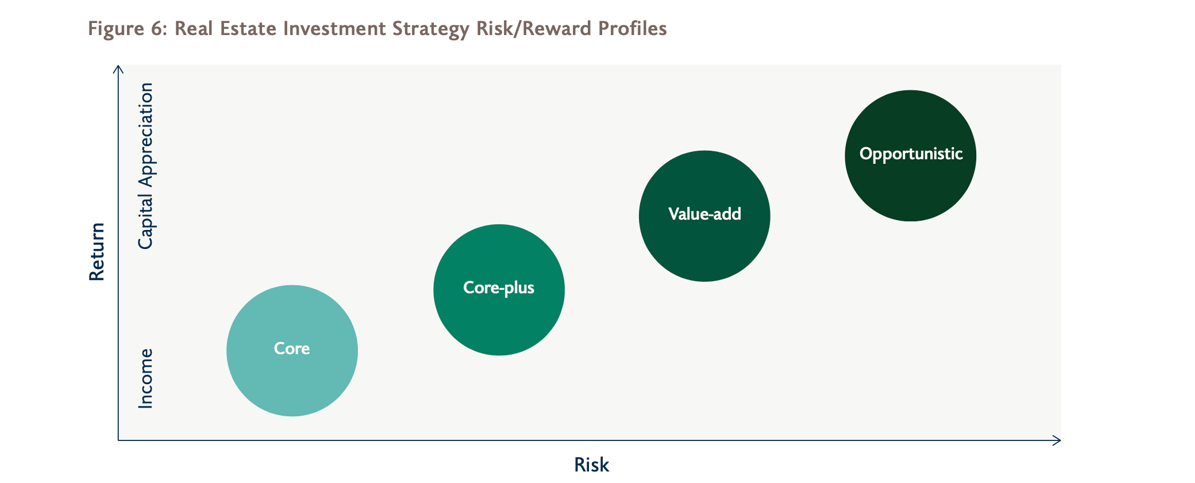

When compared with other real estate strategies (Figure 6), opportunistic real estate may offer the highest risk/return potential. As these investments are speculative in nature, they come with more associated risk—but with an experienced manager, they can also offer the potential for greater returns. Opportunistic investments may also employ higher leverage relative to other, lower-returning real estate strategies, as the underlying properties often require substantial up-front capital for capital improvements.
As opportunistic real estate investments require extensive work and time to realize results, they should be considered long-term investments. Cash flow to investors can be limited—particularly during execution of the business plan, which can involve expenses such as construction or renovation projects—before reaping the full benefit of strategy execution. To better stagger payments to investors, managers often complete projects in phases, allowing for cash flow and exits during the lifetime of the investment.
In essence, if an investor is targeting a larger total return over an extended time horizon and is less risk-averse, opportunistic real estate could be the right fit as part of an overall portfolio. When it comes to implementation, investors can access the strategy through a variety of vehicles. Closed-end funds can be an ideal vehicle, as they offer longer fund terms—typically around 10 years—that give managers the flexibility to acquire, rehabilitate and exit assets in the fund, which is often a multiyear process.


What to Look for in an Opportunistic Real Estate Manager
Opportunistic real estate investing is about successfully capitalizing on opportunities to acquire mismanaged assets
or businesses for value to generate significant returns. As such, careful manager selection is paramount—and it’s important to identify a manager that can help mitigate risks and drive better outcomes (Figure 7).
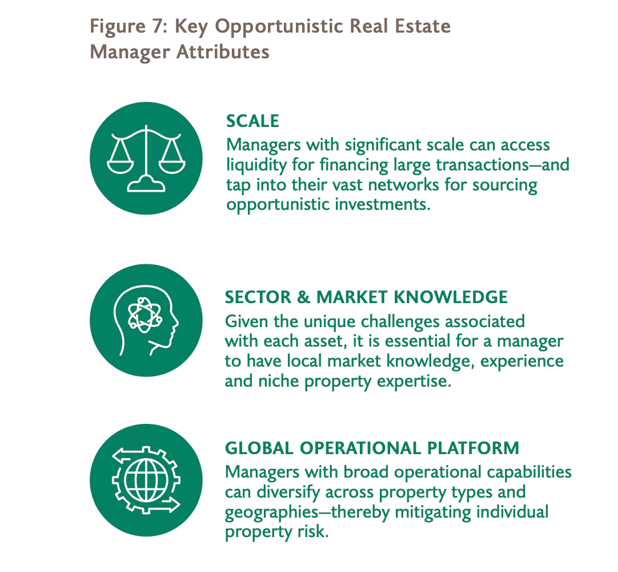

Opportunistic real estate investing can be complex, and it requires a high degree of manager skill and sophistication. Selecting a manager with the right attributes can help minimize risks and maximize the potential for greater returns.


All investing involves risk. The value of an investment will fluctuate over time, and an investor may gain or lose money, or the entire investment. Past performance is no guarantee of future results.
As an asset class, private credit is comprised of a large variety of different debt instruments. While each has its own risk and return profile, private credit assets generally have increased risk of default, due to their typical opportunistic focus on companies with limited funding options, in comparison to their public equivalents. Because private credit usually involves lending to below investment grade or non-rated issuers, yield on private credit assets is increased in return for taking on increased risk.
©2025 Brookfield Corporation; ©2025 Brookfield Asset Management Ltd.; ©2025 Oaktree Capital Management, L.P.; ©2025 Brookfield Oaktree Wealth Solutions LLC; & ©2025 Brookfield Public Securities Group LLC. Brookfield Oaktree Wealth Solutions LLC and Brookfield Public Securities Group LLC are indirect majority-owned subsidiaries of Brookfield Corporation.
The information contained herein is for educational and informational purposes only and does not constitute, and should not be construed as, an offer to sell, or a solicitation of an offer to buy, any securities or related financial instruments. This commentary discusses broad market, industry or sector trends, or other general economic or market conditions, and it is being provided on
a confidential basis.
Important Disclosures
Information herein contains, includes or is based on forward-looking statements within the meaning of the federal securities laws, specifically Section 21E of the Securities Exchange Act of 1934, as amended, and Canadian securities laws. Forward-looking statements include all statements, other than statements of historical fact, that address future activities, events or developments, including, without limitation, business or investment strategy or measures to implement strategy, competitive strengths, goals, expansion and growth of our business, plans, prospects and references to our future success. You can identify these statements by the fact that they do not relate strictly to historical or current facts. Words such as “anticipate,” “estimate,” “expect,” “project,” “intend,” “plan,” “believe” and other similar words are intended to identify these forward-looking statements. Forward-looking statements can be affected by inaccurate assumptions or by known or unknown risks and uncertainties. Many such factors will be important in determining our actual future results or outcomes. Consequently, no forward-looking statement can be guaranteed. Our actual results or outcomes may vary materially. Given these uncertainties, you should not place undue reliance on these forward-looking statements. This communication is not intended to provide an overview of the terms applicable to any products sponsored by Brookfield Corporation and its affiliates (together, “Brookfield”). Information and views are subject to change without notice. Some of the information provided herein has been prepared based on Brookfield’s internal research, and certain information is based on various assumptions made by Brookfield, any of which may prove to be incorrect. Brookfield may not have verified (and disclaims any obligation to verify) the accuracy or completeness of any information included herein, including information that has been provided by third parties, and you cannot rely on Brookfield as having verified any of the information. The information provided herein reflects Brookfield’s perspectives and beliefs as of the date of this commentary.
Forward-Looking Statements
Investment Products: Not FDIC Insured | May Lose Value | Not bank Guaranteed
brookfieldoaktree.com
info@brookfieldoaktree.com
+1 855-777-8001
All information is deemed reliable but not guaranteed and should be independently reviewed and verified.
* Information in this message, including information regarding targeted returns and investment performance, is provided by the sponsor of the investment opportunity and is subject to change. Forward-looking statements, hypothetical information or calculations, financial estimates and targeted returns are inherently uncertain. Such information should not be used as a primary basis for an investor’s decision to invest. You should not invest unless you can sustain the risk of loss of capital, including the risk of total loss of capital.


NEWSLETTER
Subscribe for a monthly financing market update. Take advantage of our pulse on the market.
CONTACT
(305) 726-6972
info@primepartners.capital
Miami, FL 33101
